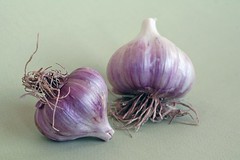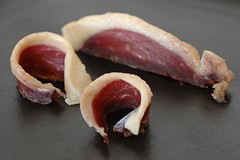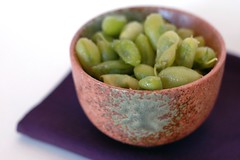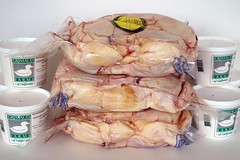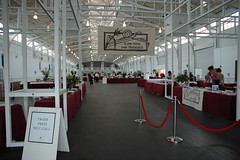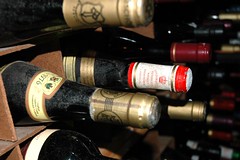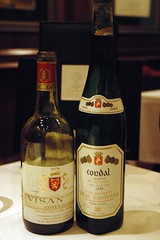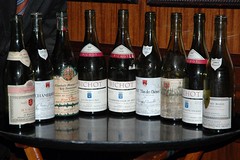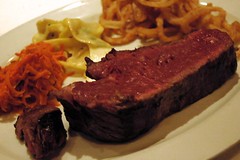The final part of our October travelogue. See Long Island, Part 1, Long Island, Part 2, The Ultimate Lavish Dinner, wd-50, and New York minutes.
Bern Laxer collected things with pathological zeal. Big things—much of the real estate on Tampa's South Howard Avenue—and small things—boxes of metal dim sum steamers that he found in San Francisco.
And wine. He bought cases of any wine he liked. Fifty. Sixty. One hundred. Whatever he could get.
Bern's obsessive collecting habit left his restaurant Bern's Steakhouse with one of the world's largest wine lists: 6,500 table wines, 1,000 dessert wines, 240 scotches, and 220 cognacs. The restaurant can only hold 110,000 bottles in the cellar, but three nearby warehouses hold the rest of the inventory.
When Wine Spectator first created the Grand Award for excellence in a wine list, Bern's was one of only 13 restaurants to receive it in the first year. It has held the award almost every year since, losing it in 1999 only because the original book's maps and stories and inserts prevented frequent updates. (Curiously, one of the other original Grand Awards went to a fancy Berkeley restaurant, though perhaps not the one that comes to mind. Can anyone guess what it was?)
You'll find recent vintages, but most of the bottles seem to come from the 1940's through 1980's. It's not hard to find bottles stretching back to the early 1900's or late 1800's, and that's before you hit the dessert wines, which go back further.
The wines aren't in the look-but-don't-touch category. They're priced to move. The Bern's wine list isn't just one of the biggest, it's also full of great values.
For Example
I called ahead to discuss our dinner with wine director Eric Renaud, whom I had interviewed for my wine list article—Melissa and I were not anonymous by any stretch of the imagination. I gave him a price range, said there was no point in flying to Tampa to taste a bottle I could get anywhere, and asked him to find something interesting.
Eric started us with a 1949 Condal Reserva from Rioja Santiago, a "Red Rioja Wine." As with all the wines I tried at Bern's, I would have believed you if you told me the wine was twenty years younger. The wine still had deep, fruit aromas, with smoke and leather components and a cedar note that evolved into spice. I called it "ethereal" in my tasting notes, but the night was still young. The cost? $95.
Seem steep to you? How about a 1978 Visan Côtes-du-Rhône for $30? This wine had a captivating mix of fruit and earth (my notes were a bit fuzzy by this point in the evening).
After those wines, the 1980 Ridge Vineyards Fiddletown Zinfandel seemed overpriced at $44.50, but it did offer a unique perspective on an old Zinfandel when we drank it on our second visit. The wine had earthy, nutty, even musty aromas that became more mushroomy as the wine opened, but the flavor was sprightly fruit.
The Table Next to Us
But the real eye-poppers were at the table next to us.
When I talked to Eric beforehand, he told me he'd put me in the exclusive Andre Tchelistcheff room, where a group of doctors and lawyers would be enjoying a Burgundy dinner surrounded by photos of the famous wine maker. "They're nice folks; they might share some," he said, "but at the very least you'll get to see them open some impressive bottles."
I was chatting them up almost before the waiter pulled out our chairs.
They ordered ten different burgundies. The youngest was a 1962 Musigny, the oldest a 1942 Musigny. I won't disclose what the party spent, but given the Bern's prices, it was about a quarter of what they would have spent elsewhere—if they could even do this dinner anywhere else. The host learned of my job (the writing one), and offered us some tastes. "We're not going to drink them all," my new best friend said genially as he brought over glasses with small tastes.
I've tasted some pretty decent wines in my life. But the 1942 Musigny from J. Faivelet was the best wine I've ever had. It tasted like something pulled from a dark forest grotto littered with black truffles. I can barely express the complexity in this wine. (Melissa watched me taste some and thought to herself, "I guess I'm driving back to the hotel.")
What About the Food
Wine without a good meal is a sterile thing, and Bern's fills plates as well as it fills glasses. Bern's is one of the few restaurants that dry-ages its own beef for thirty days—most don't dry-age at all—to give the meat a deeper, more complex flavor. While you can get steak as good in San Francisco or New York, for most diners the steak will probably be a step up from the norm.
You order your steak by cut, thickness, and doneness. I think I ordered the filet mignon, but Fatemeh insists that you should order the Delmonico. Maybe on our next trip.
But don't just make room for the steak. Bern's offers an extensive caviar menu. I resisted the urge to order a rare caviar from a heavily overfished stock, and followed my principles to a high-end domestic choice. You can order your caviar with classic accompaniments or flavored butters. We couldn't decide, so our waiter brought us both. They also brought us a boat of each of the nine salad dressings when we commented that it would be hard to choose. (I don't know if this is normal for everyone, normal for diners in the Andre Tchelistcheff room, or normal for writers who just wrote a glowing commentary about your wine list).
The second night we had appetizers at Sidebern's, the exact opposite of Bern's. Though not a destination restaurant like its big brother, you shouldn't miss the global cuisine and modern wine list if you'll be in Tampa for longer than a trip to Bern's. Take some time to peruse the wine store in the same building as Sidebern's, since the restaurant often uses this retail space to sell ready-to-drink old bottles that won't move fast enough in the restaurant.
Would we go back? We want to subscribe to Jet Blue's specials on flights to Tampa.
Want more photos? See Melissa's photo set from our Tampa trip.

